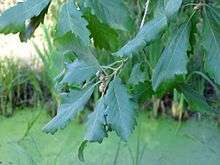Quercus canariensis
| Algerian oak | |
|---|---|
 | |
| Scientific classification | |
| Kingdom: | Plantae |
| (unranked): | Angiosperms |
| (unranked): | Eudicots |
| (unranked): | Rosids |
| Order: | Fagales |
| Family: | Fagaceae |
| Genus: | Quercus |
| Section: | Mesobalanus |
| Species: | Q. canariensis |
| Binomial name | |
| Quercus canariensis Willd. 1809 | |
| Synonyms[1] | |
|
List
| |
Quercus canariensis, the Algerian oak or Mirbeck's oak is an oak in the section Quercus sect. Mesobalanus, native to southern Portugal, Spain, Tunisia, Algeria and Morocco; despite the scientific name, it does not occur naturally today in the Canary Islands, though it may have in the past.[2]
Description
Quercus canariensis is a medium-sized deciduous to semi-evergreen tree growing to 20–30 m tall with a trunk up to 1.5 m diameter. The leaves are 10–15 cm long and 6–8 cm broad, with 6-12 pairs of shallow lobes. The flowers are catkins; the fruit is an acorn 2.5 cm long and 2 cm broad, in a shallow cup.[3]
Landmark specimens
The picture to the left is of a grand old Algerian oak tree that was planted on 19 May 1863. It resides within the Kyneton Botanical Gardens in the town of Kyneton in the Australian state of Victoria. This tree is listed by the National Trust on the Register of Significant Trees in Victoria. There are also two good specimens located in the Ballarat Botanical Gardens, one of which is believed to have been planted in 1920. There was another significant old Algerian oak tree in Victoria at the Melbourne Royal Botanic Gardens. It was known as Lady Loch's Oak - however its trunk split in half in November 2007, due to the weight of its giant old limbs. The tree has been extensively planted in Canberra.
References
External links
| Wikimedia Commons has media related to Quercus canariensis. |